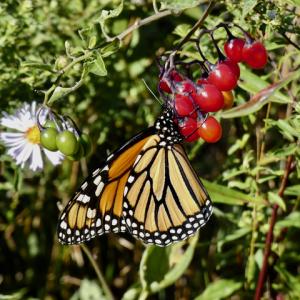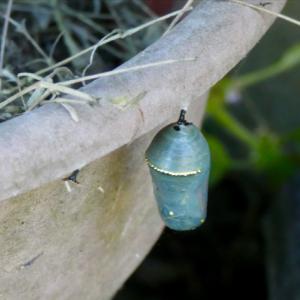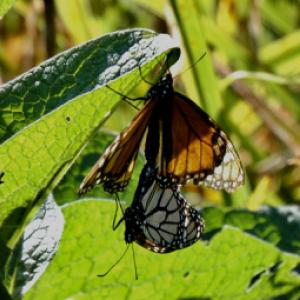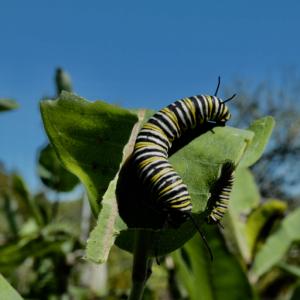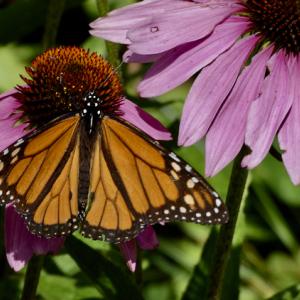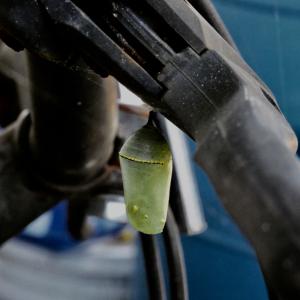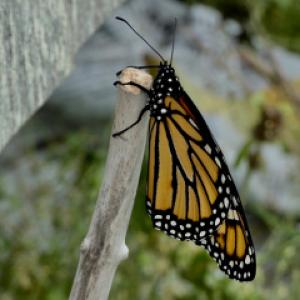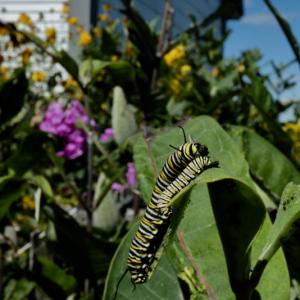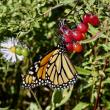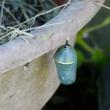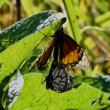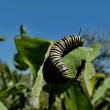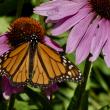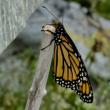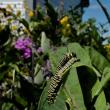Kristen Lindquist: A resurgence of monarch butterflies?
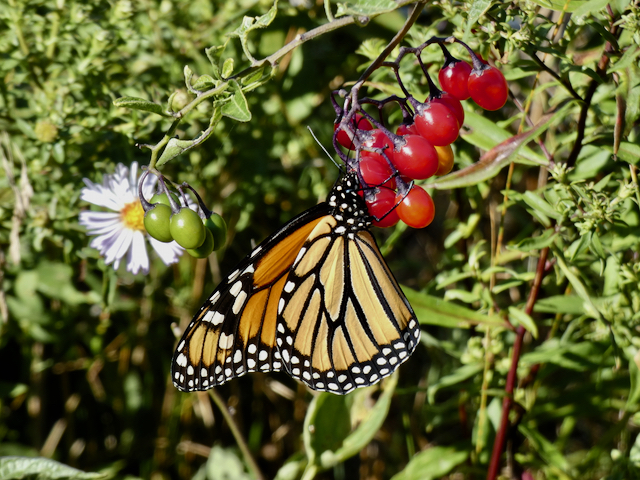 An adult monarch sips from the ripe berries of deadly nightshade. (Photo by Kristen Lindquist)
An adult monarch sips from the ripe berries of deadly nightshade. (Photo by Kristen Lindquist)
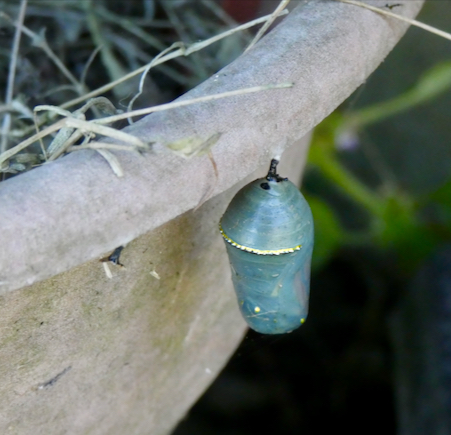 The wings of the butterfly inside are starting to show in this chrysalis, which hatched the next day.
The wings of the butterfly inside are starting to show in this chrysalis, which hatched the next day.
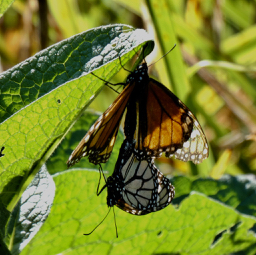 Monarchs mating. She will lay her eggs on milkweed plants. (Photo by Kristen Lindquist)
Monarchs mating. She will lay her eggs on milkweed plants. (Photo by Kristen Lindquist)
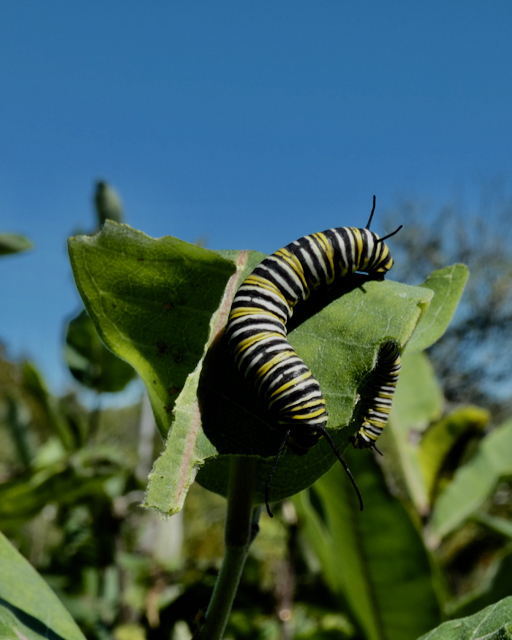 Monarch caterpillars eat only milkweed leaves. (Photo by Kristen Lindquist)
Monarch caterpillars eat only milkweed leaves. (Photo by Kristen Lindquist)
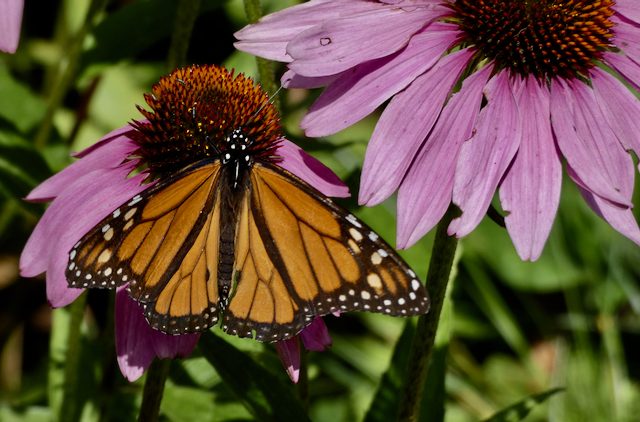 This male monarch visited my coneflowers this summer. (Photo by Kristen Lindquist)
This male monarch visited my coneflowers this summer. (Photo by Kristen Lindquist)
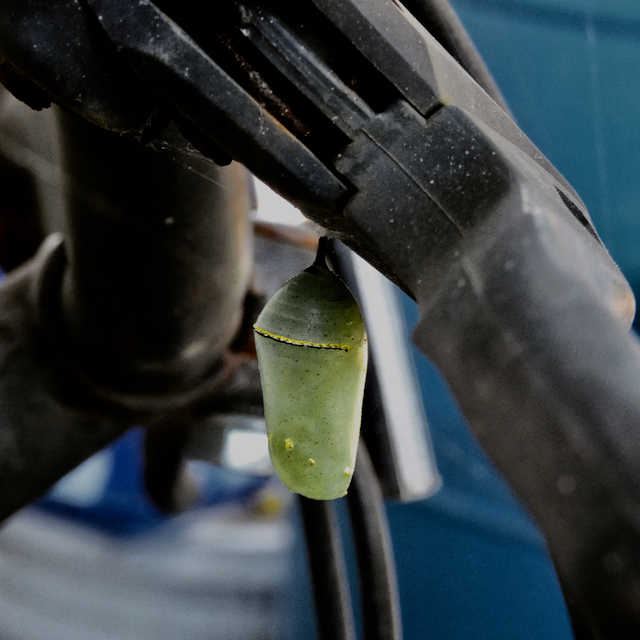 An unused bicycle hosted at least four chrysalises, including this one on the handlebars. (Photo by Kristen Lindquist)
An unused bicycle hosted at least four chrysalises, including this one on the handlebars. (Photo by Kristen Lindquist)
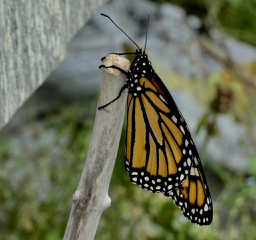 A newly emerged monarch hangs out while its wings dry and strengthen. (Photo by Kristen Lindquist)
A newly emerged monarch hangs out while its wings dry and strengthen. (Photo by Kristen Lindquist)
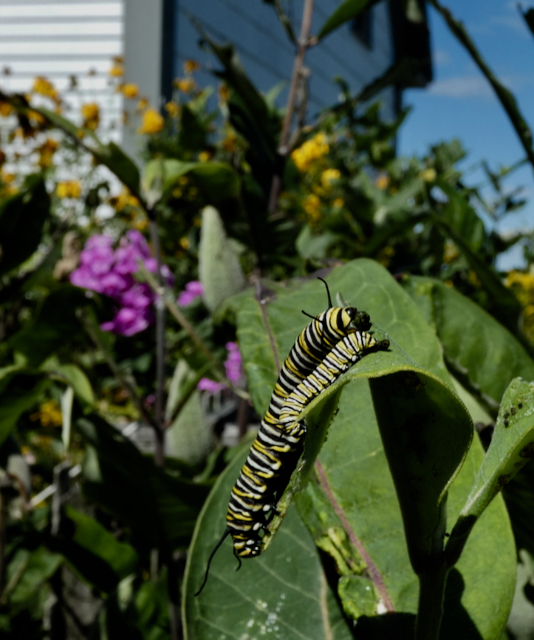 Monarch caterpillars shed five times as they grow. (Photo by Kristen Lindquist)
Monarch caterpillars shed five times as they grow. (Photo by Kristen Lindquist)
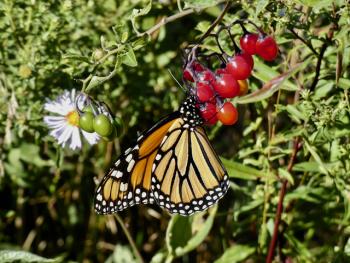 An adult monarch sips from the ripe berries of deadly nightshade. (Photo by Kristen Lindquist)
An adult monarch sips from the ripe berries of deadly nightshade. (Photo by Kristen Lindquist)
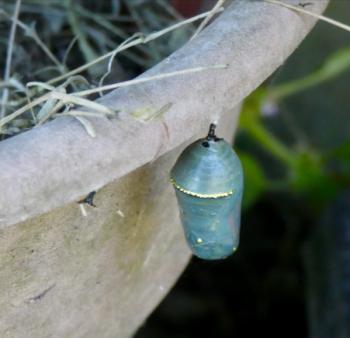 The wings of the butterfly inside are starting to show in this chrysalis, which hatched the next day.
The wings of the butterfly inside are starting to show in this chrysalis, which hatched the next day.
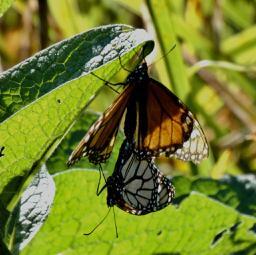 Monarchs mating. She will lay her eggs on milkweed plants. (Photo by Kristen Lindquist)
Monarchs mating. She will lay her eggs on milkweed plants. (Photo by Kristen Lindquist)
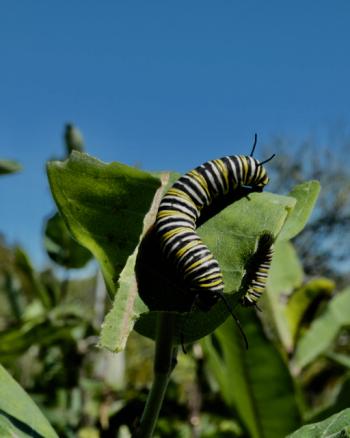 Monarch caterpillars eat only milkweed leaves. (Photo by Kristen Lindquist)
Monarch caterpillars eat only milkweed leaves. (Photo by Kristen Lindquist)
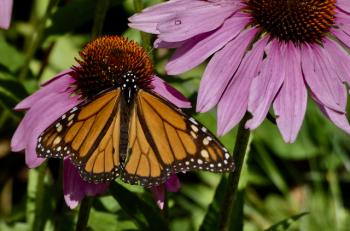 This male monarch visited my coneflowers this summer. (Photo by Kristen Lindquist)
This male monarch visited my coneflowers this summer. (Photo by Kristen Lindquist)
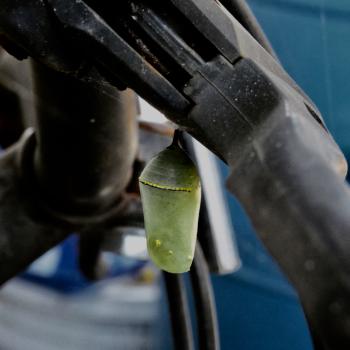 An unused bicycle hosted at least four chrysalises, including this one on the handlebars. (Photo by Kristen Lindquist)
An unused bicycle hosted at least four chrysalises, including this one on the handlebars. (Photo by Kristen Lindquist)
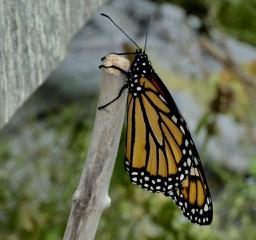 A newly emerged monarch hangs out while its wings dry and strengthen. (Photo by Kristen Lindquist)
A newly emerged monarch hangs out while its wings dry and strengthen. (Photo by Kristen Lindquist)
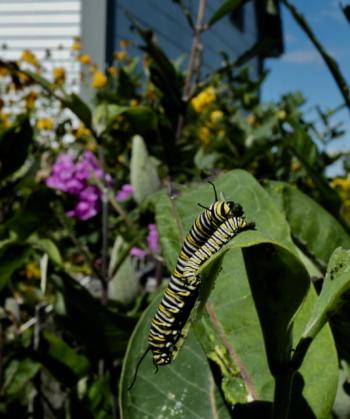 Monarch caterpillars shed five times as they grow. (Photo by Kristen Lindquist)
Monarch caterpillars shed five times as they grow. (Photo by Kristen Lindquist)
During my annual fall pilgrimage to Monhegan Island to enjoy the spectacle of bird migration, I’ve found myself paying more and more attention in recent years to butterflies—especially the familiar monarch.
Sure, it’s another creature with wings. But my attention to this striking tiger-striped insect goes well beyond that. For one thing, I’m not sure how much longer it will be around. Monarch populations have seriously declined over the past several decades. This has been observed anecdotally here in Maine—three Septembers ago I saw only two monarchs on Monhegan!—as well as statistically around the country. This January, for instance, CNN reported that the population of western monarchs wintering on the California coast had dropped 86 percent since 2017. That’s fewer than 30,000 butterflies.
Fortunately, eastern monarchs, including “our” butterflies here in Maine, appear to be rebounding. This past winter, scientists at the butterfly’s famous wintering grounds in Mexico shared more positive news. According to “Insects on Plants, Chemical Ecology, and Coevolution,” a website of Cornell University’s Phytophagy Lab, the overwintering population this past winter was more than double that of the previous winter—the highest it’s been in a decade.
But we can’t be complacent about the monarch’s apparent recovery here in the East. Overall population trends are still downward, thanks to a gauntlet of continuing threats. It wouldn’t take much to cause their numbers to take a dive again. As the Center for Biological Diversity reminds us: “Monarchs need a very large population size in order to be resilient to threats from severe weather events, pesticides, and climate change. To put things to scale: A single storm in 2002 killed an estimated 500 million monarchs.” To put that even more into perspective: That’s about 200 million more butterflies than were estimated last winter in the Mexican highlands.
The relatively good news of this past winter aside, concern has grown that the overall North American monarch population may be headed for extinction. After being petitioned by several environmental organizations, the U.S. Fish and Wildlife Service determined in 2014 that the monarch was deserving of “threatened” status under the Endangered Species Act (ESA). However, the subsequent, required review of the species was never completed, so this status—and any protections that might result—never became official. And recent political moves to further weaken the ESA, including deregulation of some highly toxic pesticides, have undermined the benefits of a legal status change at this stage.
In the short term, however, this seemed to be a bountiful summer for monarchs here in Maine. I’ve spotted more than usual in my own small flower garden, as well as in other local gardens and nature preserves that host the milkweed plants on which monarchs lay their eggs.
Out on Monhegan over Labor Day weekend, I was heartened to note great numbers of monarchs flying all over the island. The monarch mother lode in recent years has been found at the Trailing Yew, one of the island’s inns. The inn has encouraged a dense patch of native milkweed to fill in a good portion of its kitchen garden area, resulting in the proliferation of monarchs in all stages of life. On my recent visit, I saw mating adult butterflies, caterpillars of various sizes, chrysalises galore, newly hatched adults drying their bright new wings, and dozens of adult butterflies flitting around wild and cultivated flowers alike.
Staff at the Yew have put up a sign to warn visitors to watch their step in the “Monarch Nursery,” and this warning is not in jest. Chrysalises literally hang everywhere there right now: not just on milkweed plants, but also on the windows and sills of the main inn building, nearby buckets, a bench, the pantry wall, the kitchen fuel tanks, and even the seat and handlebars of an unused bicycle. These beautiful jade green casings dotted with what looks like gold leaf are works of art, true marvels of nature. With close observation, you may see the dark pattern of the butterfly’s wings inside, as it gets closer to hatching.
The caterpillar, the butterfly’s larval stage, is easily spotted crawling all over the milkweed plants. These white caterpillars with thin black and yellow stripes are picky eaters, eating only milkweed leaves. This exclusive diet makes the species especially vulnerable: no milkweed, no monarchs.
With their milkweed-only diet, they make themselves inedible. Milkweed sap contains toxins which make all stages of the monarch’s life cycle—from caterpillar to butterfly—poisonous. During fall migration, when both falcons and butterflies are passing over the island, I’ve watched a hungry Merlin snap up a monarch and then quickly spit it back out. Once a Merlin tastes one toxic butterfly, it avoids others, which undoubtedly aids the overall survival of the species (as well as its look-alike, the viceroy butterfly).
As the caterpillar chows down on milkweed, it grows bigger and bigger, shedding its skin like a snake five times. When it’s gotten as big as it’s going to get, it finds an undisturbed place, makes a little mat, and hangs from it upside-down in a J shape. (The Yew staff call this “J’ing up.”) Within a day, it has shed its skin one final time to reveal the pale green chrysalis that has been waiting underneath all this time. This new “skin” quickly hardens to form the chrysalis casing of the butterfly’s pupal stage.
Within two weeks, a miraculous reorganization and transformation of the caterpillar’s internal organs takes place within the chrysalis. What was once a pale-bodied crawling creature with a chewing mouth eventually emerges as a big orange flying insect with a nectar-sipping tongue.
But that’s not the final miracle of this amazing insect’s life. Like many of us, the butterflies born on Monhegan and throughout Maine this summer and early fall can’t tolerate the cold of winter. So soon enough, the summer’s final generation of butterflies will each take to the skies and begin their long migration southward, right along with the birds. You can see it happen, standing on the beach in Lobster Cove at the south end of the island. As you watch, these seemingly delicate insects flutter out, one by one, over the wave-churned ocean, powered by some unfathomable life force deep within them. With your heart in your throat, you follow each tiny creature until it vanishes in the distance, on its way to warmer climes over 2,000 miles away. And it will never return.
Kristen Lindquist is an amateur naturalist and published poet who lives in her hometown of Camden.
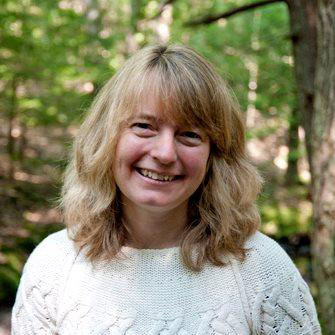
Event Date
Address
United States

